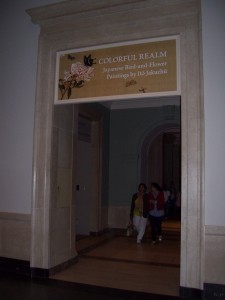Living in Washington D.C, it’s easy to forget just how close I am to some of the world’s greatest art. I am literally a 30-minute drive from the fabled, but oft-publicized monuments and statehouses that comprise our nation’s capital. These neo-classical structures are themselves works of art. Seeing them on TV (and on currency) has somehow elevated them to a near-mythical status in my eyes. But, as I recently discovered, some of our most awe-inspiring national treasures are also some of the most accessible.
As a recent transplant from Denver, Colorado, I have been fascinated by the East Coast and all of its inherent history. Words like “Roanoke, Shenandoah, and Potomac evoke a spirit of wonder and mystery to my western-raised imagination. To me, Washington D.C. represents somewhat of an undiscovered country, rich with new treasures and artifacts to discover, especially when it comes to art.
For my first foray into this new world, I decided to start with the obvious and venture into the heart of Washington D.C, the National Mall. This generous portion of land is at the epicenter of D.C. arts and culture. I headed down to the National Gallery of Art, one of the many renowned (and free) D.C. museums hoping to find something spectacular and I wasn’t disappointed.
I was fortunate enough to catch “Colorful Realm: Japanese Bird-and-Flower Paintings by Ito Jakuchu” before the end of its April run. These paintings were done in a ten-year span between 1757 and 1766, roughly during the same time period that the American Revolution was taking place, a half-world away.
As the title suggests, the focus of these paintings were of the natural world and they beautifully illustrated the differences between Eastern and Western approaches to art. Depictions of cranes, fish, and other Japanese flora and fauna were exquisitely rendered on silk scrolls. Blossoming trees were cropped in close, as central to the composition as the subject. Like other Eastern works, nature was emphasized, rather than human subjects. In fact, the only human figures drawn were of three individual scrolls depicting the Buddha. Apparently, Jakuchu was inspired by traditional Chinese Zen paintings and incorporated this influence into his innovative style.
Outside of Japan, this collection has never before been seen in its entirety, which also made this an especially rare and exciting art outing. For my first adventure into the wonders of D.C. art, I was excited to find this gem!
***SPECIAL NOTE ON DRIVING THROUGH WASHINGTON D.C: For those who are new to the D.C. area, the traffic conditions can be alarming and stressful. Most of the time, conventional driving timetables should be thrown out of the window due to the many drivers trying to enter or leave the D.C. metro area. This condition is compounded by the ubiquitous construction projects happening on nearly every major interchange. Also, like much of the East Coast, the roads aren’t always straight or contiguous, especially in D.C. I suggest investing in a superior GPS unit and/or giving yourself plenty of buffer time to effectively navigate your way to where you need to go.
I happened to travel during the middle of the week, during the middle of the day, so driving and parking was somewhat reasonable. If you decide to venture into the city during peak commuter times, or weekends, expect high volumes of traffic.

- Itō Jakuchū Peonies and Butterflies (J. Shakuyaku gunchō zu), c. 1757 (Hōreki 7) ink and color on silk, from Colorful Realm of Living Beings (J. Dōshoku sai-e), set of 30 vertical hanging scrolls, c. 1757–1766 Sannomaru Shōzōkan (The Museum of the Imperial Collections), The Imperial Household Agency

